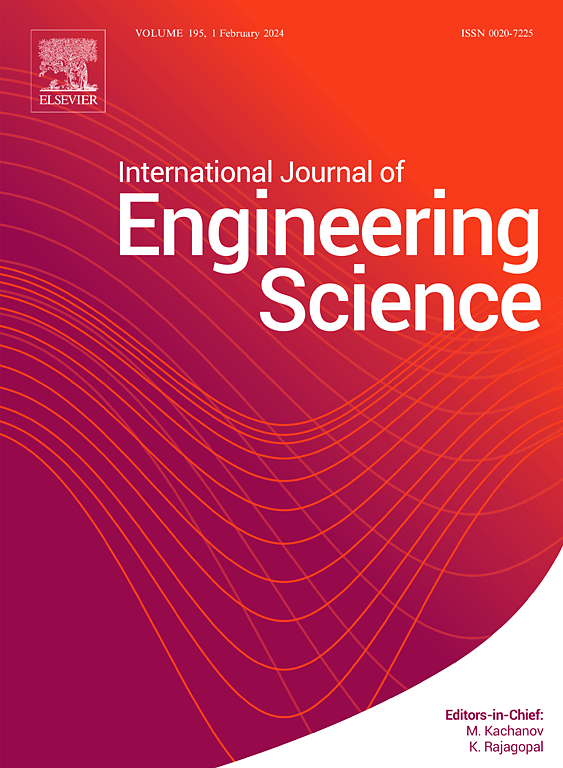聚氯乙烯胶基电子电活性聚合物双极化驱动的微观电化学-力学模型
IF 5.7
1区 工程技术
Q1 ENGINEERING, MULTIDISCIPLINARY
International Journal of Engineering Science
Pub Date : 2025-09-02
DOI:10.1016/j.ijengsci.2025.104375
引用次数: 0
摘要
基于聚氯乙烯凝胶(PVCG)的电活性聚合物具有可调的刚度,并且在中等驱动电压(200-3000 V)下实现快速响应的大应变,使其适用于多种工程应用。PVCG的电致动响应涉及增塑剂的电化学迁移率与PVC链的电模量之间的强微观机制耦合。其中,增塑剂极化诱导的电迁移产生极化应力和渗透应力,这是PVCG中高驱动应变的主动驱动力,而聚合物骨架极化诱导的构象转变影响了PVCG的电模量,阻碍了变形过程。本文建立了一个电化学-力学模型,揭示了PVCG在热一致大变形框架下的双极化致动机理。首先,我们求解了电激发下单个聚合物链的极化和动态演化,以及单个增塑剂分子。然后根据全网络模型,通过统计力学对PVCG的总自由能函数进行积分。随后,根据八链模型的核心原理,对基于微观机制的本构关系进行简化,通过平均方向解析纳入有效拉伸和电场。实现了有限元实现,并通过一系列试验对模型进行了标定。分析了双极化致动特性和循环活化下PVCG的记忆效应。此外,还对伸缩驱动器和自感知变刚度人工肌肉模型进行了仿真,以展示我们的数值模拟能力的广泛适用性。本研究为PVCG在驱动领域的宏/微尺度提供了理论认识和设计指导。本文章由计算机程序翻译,如有差异,请以英文原文为准。
Micromechanism-based electrochemo-mechanical model for double polarization-actuation of PVC gel-based electronic electroactive polymer
The polyvinyl chloride gel (PVCG)-based electroactive polymer exhibits tunable stiffness and achieves large strains with rapid response at moderate drive voltages (200–3000 V), making it suitable for versatile engineering applications. The electric actuation response of PVCG involves a strong micromechanism-characterized coupling between the electrochemical mobility of the plasticizer and the electro-modulus of PVC chain. Specifically, plasticizer polarization-induced electromigration generates polarization stress and osmotic stress, which act as the active driving forces for high actuation strain in PVCG, while polymer skeleton polarization-induced conformational transformation influences the electro-modulus of PVCG, impeding the deformation process. This work formulates an electrochemo-mechanical model to unravel the double polarization-induced actuation mechanism of PVCG under a thermodynamically consistent large deformation frame. First, we solve the polarization and dynamic evolution of a single polymer chain under electric excitation, as well as a single plasticizer molecule. The total free energy function of PVCG is then integrated through statistical mechanics in line with the full-network model. Subsequently, micromechanism-based constitutive relations are simplified following the core principles of the eight-chain model, incorporating effective stretch and electric field through average directions analytically. The finite element implementation is realized and the model is calibrated through a series of tests. Double polarization-induced actuation properties and the memory effect of PVCG under cyclic activation are analyzed. Additionally, a telescopic driver and a self-sensing variable stiffness artificial muscle model are simulated to showcase the wider applicability of our numerical simulation capability. This work provides theoretical understanding and design guidelines for PVCG at macro/micro scales in the actuation field.
求助全文
通过发布文献求助,成功后即可免费获取论文全文。
去求助
来源期刊

International Journal of Engineering Science
工程技术-工程:综合
CiteScore
11.80
自引率
16.70%
发文量
86
审稿时长
45 days
期刊介绍:
The International Journal of Engineering Science is not limited to a specific aspect of science and engineering but is instead devoted to a wide range of subfields in the engineering sciences. While it encourages a broad spectrum of contribution in the engineering sciences, its core interest lies in issues concerning material modeling and response. Articles of interdisciplinary nature are particularly welcome.
The primary goal of the new editors is to maintain high quality of publications. There will be a commitment to expediting the time taken for the publication of the papers. The articles that are sent for reviews will have names of the authors deleted with a view towards enhancing the objectivity and fairness of the review process.
Articles that are devoted to the purely mathematical aspects without a discussion of the physical implications of the results or the consideration of specific examples are discouraged. Articles concerning material science should not be limited merely to a description and recording of observations but should contain theoretical or quantitative discussion of the results.
 求助内容:
求助内容: 应助结果提醒方式:
应助结果提醒方式:


